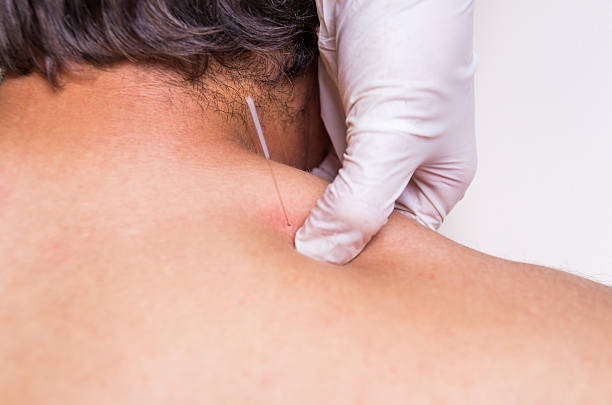Dry needling is a procedure where filiform needles are tapped through the skin to the target tissue to bring about a therapeutic effect. No medicine is delivered, thus it is called “dry”, compared to injections, which are “wet”. Other names are IMS, TrP DN etc.
NEEDLES:
Needles can be as short as12.5 mm or as long as 100 mm. the choice of needle is based on the target tissue and specific techniques used. Disposable filiform acupuncture needle with guide tube is used. (filiform= solid). Guide tube minimizes pain.
DISPOSABLE STERILE NEEDLE:
NEEDLES WITH GUIDE TUBE:
NEEDLES SANS GUIDE TUBE:
Pathophysiology of MTrPs:
Trigger points are thought to be due to an excessive release of acetylcholine from selected motor endplates. They can be divided into Active and Latent myofascial trigger points. Active trigger points can spontaneously trigger local or referred pain. They cause muscle weakness, restricted ROM and autonomic phenomena. Latent trigger points do not cause pain unless they are stimulated. They may alter muscle activation patterns and contribute to restricted ROM. Therefore, both active and latent trigger points cause allodynia at the trigger point site and hyperalgesia away from the trigger point following applied pressure.
The formation of trigger points is caused by the creation of a taut band within the muscle. This band is caused by excessive acetylcholine release from the motor endplate combined with inhibition of acetylcholine esterase and upregulation of nicotinic acetylcholine receptors. Initially, taut bands are produced as a normal protective, physiological measure in the presence of actual or potential muscle damage. They are thought to occur in response to unaccustomed eccentric or concentric loading, sustained postures and repetitive low-load stress.
However, when sustained they contribute to sustained pain. Pain caused by trigger points is due to hypoxia and decreased blood flow within the trigger point. This leads to a decreased pH which activates the muscle nociceptors to restore homeostasis. This causes peripheral sensitization. Trigger points are also involved in central sensitization. The mechanism remains unclear but trigger points maintain nociceptive input into the dorsal horn and therefore contribute to central sensitization.
Mechanisms of Action:
Dry needling has been shown to immediately increase pressure pain threshold and range of motion, decrease muscle tone, and decrease pain in patients with musculoskeletal conditions.
Its suggested mechanisms of action include:
Local Twitch Respsone: Dry needling can elicit a ‘local twitch response’ which is an involuntary spinal reflex resulting in a localized contraction of the affected muscles that are being dry-needled. Local twitch response can lead to alteration in the length and tension of muscle fibres and stimulate mechanoreceptors like A Beta fibres.
Effects on Blood Flow: Sustained contraction of taut muscle bands in trigger points might cause local ischemia and hypoxia. Dry needling causes vasodilation in the small blood vessels leading to increased muscle blood flow and oxygenation.
Neurophysiological effects: Dry needling may produce local and central nervous responses to restore hemostasis at the site of the trigger point which results in a reduction in both central and peripheral sensitization to pain.
Remote Effects: Dry needling of distal MTrP has been found to have an analgesic effect on proximal MTrP. The literature has conflicting evidence regarding the contralateral effect.
Placebo Effect: Expectations regarding dry needling can strongly influence pain perception.
Technique:
- With careful precision the structure to be needled is chosen. Then sterilized disposable needles are pierced through the skin into the target tissue.
- Choice of needle is dependent upon depth of target tissue.
- A clean field technique is used. As there is minimal or no bleeding, sterile field is not needed.
- The needles are kept inserted for a span of 30 seconds to few minutes and then withdrawn and disposed properly.
SPECIFIC TECHNIQUE:
- Deep Dry Needling: When needle is pierced deep into the muscle/target tissue. Local Twitch Response is elicited.
- Superficial Dry Needling: Started by Peter Baldry, where only the skin overlying the target tissue is pierced.
- Periosteal pecking
- Needle manipulation
- Intramuscular electrical stimulation (PENS)
Electrical Dry Needling:
Electrical dry needling (EDN) is a technique in which two needles are inserted as electrodes for passing an electric current.
One of the main advantages of using EDN in clinical practice or acupuncture research is its capacity to set stimulation frequency and intensity objectively and quantifiably.
In clinical practice, both low- and high-frequency electrostimulation are used often for diverse conditions.
Low-frequency stimulation is specifically recommended for muscular atrophy , whereas high-frequency stimulation is recommended for spinal spasticity.
INDICATIONS:
- Trigger points: Releases trigger points
- Musculoskeletal pains e.g. osteoarthritis, musculogenic LBP: for analgesia, control of muscle spasm.
- Referred pains
- Pathologies of myofascial origins: e.g. tennis elbow, plantar fascitis, shin splints- appears to accelerate the healing process.
Contraindications:
Absolute contraindications:
- In a patient with needle phobia.
- Patient unwilling – fear, patient belief.
- Unable to give consent – communication, cognitive, age-related factors.
- Medical emergency or acute medical condition.
- Over an area or limb with lymphedema as this may increase the risk of infection/cellulitis and the difficulty of fighting the infection if one should occur.
- Inappropriate for any other reason.
Relative Contraindications:
- Abnormal bleeding tendency
- Compromised immune system
- Vascular disease
- Diabetes
- Pregnancy
- Children
- Frail patients
- Patients with epilepsy
- Psychological status
- Patient allergies
- Patient medication
- Unsuitable patient for any reason
DRY NEEDLING V/S ACUPUNCTURE
About Authors
Dr. Muhammad Mahmood Ahmad is a Spinal as well as an Orthopedic Surgeon with over 14 years of experience currently practicing at Razia Saeed Hospital, Multan.











